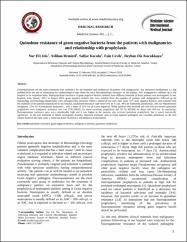Quinolone resistance of gram negative bacteria from the patients with malignancies and relationship with prophylaxis
Künye
Iris NE, Demirel A, Koculu S, Cevik E, Kucukkaya RD. Quinolone resistance of gram negative bacteria from the patients with malignancies and relationship with prophylaxis. Med-Science. 2016. doi:10.5455/medscience.2016.05.8441Özet
Fluoroquinolones are the most commonly used antibiotics for the treatment and prophylaxis of patients with malignancies. But resistance development is a big problem.With the aim of identifying the epidemiological data about the local fluoroquinolone resistance of the patients with malignancies followed up in the hospital or on outpatient basis, fluoroquinolone resistance of gram negative bacteria isolated from different materials of these patients was investigated. In our hospital, from January 2013 to August 2014, gram negative isolates that were isolated from the samples of patients with malignancies followed-up by Hematology and Oncology Departments were retrospectively analyzed. Within a period of one and a half years, 227 Gram negative bacteria were isolated from the materials of the patients hospitalized in our hospital. Quinolone resistance rates were 63% for E.coli, 49% for Klebsiella pneumoniae, 34% for Pseudomonas aeruginosa, 72% for Acinetobacter baumannii , with a mean of 52% for all Gram negatives. When patients who received and who did not receive quinolone prophylaxis were compared, resistance rate was 57% (26/61) for those receiving prophylaxis and 50 %( 83/166) for those who did not. In conclusion, fluoroquinolone resistance rates were considerably high and it was higher in the patients who received quinolone prophylaxis, but it wasn't statistically significant. In the oral treatment of febrile neutropenic patients, empirical treatment aims at Gram negative pathogens and considers quinolones as the first choice; however this data raises a suspicion about the efficacy and adequacy of quinolones.


















